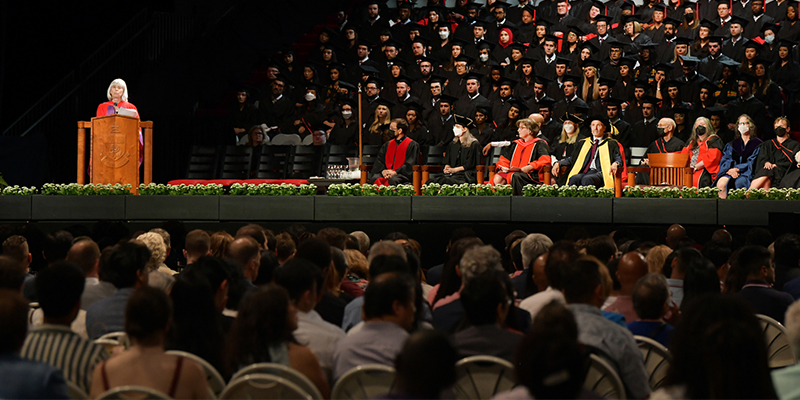
By Jenny Pitt-Clark
Osgoode alumna Constance Backhouse, a multi-disciplinary scholar, social activist and cultural critic, has published extensively reproduction, family, sexual harassment and the legal profession. Her work has influenced government policy. On June 17, Backhouse returned to York University to receive an honorary doctor of laws during the Osgoode convocation ceremony.
Backhouse, who holds the positions of Distinguished University Professor and University Research Chair at the Faculty of Law, University of Ottawa, began her convocation address by setting the theme for her remarks. “My work focuses on Canadian legal history and sex and race discrimination in law. Today, I want to remind everyone of the struggles for entry of groups long excluded from the legal profession,” she told graduands. “For centuries, membership in the coveted Canadian legal profession was restricted to white males. The first outsiders to pierce the white male bubble faced enormous barriers and enduring hostility.”

Backhouse then delivered a masterclass in Canadian legal history. She spoke to graduands about the importance of equity, diversity and inclusion in the legal profession through the stories of those who broke through barriers and laid the groundwork for future generations.
“Robert Sutherland now considered the ‘first Black lawyer,’ was called to the Ontario bar more than a century and a half ago, in 1855,” said Backhouse. “The son of a free Black woman and Scottish father, he came from Jamaica to study law at Queen’s University.”
Sutherland, said Backhouse, fought racist social and cultural norms, segregation and discrimination. He established his law practice in southwestern Ontario. He is renowned for having left his estate to Queen’s University, bailing the school from imminent bankruptcy some 20 years later.
Another Black lawyer, Delos Davis, moved to Canada from the United States with his parents, who were former slaves. Davis was unable to article for more than 10 years because he was Black, and he was forced to obtain special permission from the provincial government, said Backhouse. “His call to the bar in 1886 came over the repeated protests of the Law Society. Davis defended many Black criminal clients, and he was forced to develop special strategies to fight for fairness inside a Criminal Justice system riddled with racist police, judges and jurors.”
In 1897, Clara Brett Martin broke the gender barrier when she was called to the bar in Toronto, the first woman in the entire British Commonwealth. “Women were still forbidden to vote, to be elected as politicians, to sit on juries, or serve as judges,” said Backhouse, noting that at 23-years-old, she successfully navigated a six-year battle of initial rejection, two provincial statutes, multiple bencher debates, a tied Law Society vote broken only by the treasurer’s vote and faced significant sexual harassment.
“It took another half-century before Canada’s first Asian-Canadian lawyer, Kew Dock Yip, was called to the Ontario bar in 1945. Educated at Columbia, the Univ of Michigan, and UBC, it took him three tries just to get admitted to Osgoode Hall Law School,” noted Backhouse. “He was a driving force in the campaign to repeal the racist Chinese Exclusion Act, which had shut down Asian immigration for decades.”
Indigenous lawyers faced impenetrable barriers. Backhouse offered the example of Andrew Paull, a member of the Squamish Nation. Paull worked in a law office in 1917 but was denied admission to the British Columbia bar for four years. “As an Indigenous man, he was barred from the vote. He went on to become one of Canada’s most significant advocates for Indigenous rights, without a law degree,” said Backhouse.
In 1938, legal historians think that Norman Lickers may have become the first Indigenous lawyer in Canada. He was a raised in the Six Nations Territory and was placed in the Mohawk Institute Residential School. Lickers graduated from Osgoode and practiced criminal law in Brantford, Ontario.
“His disbarment in 1950 should send up a red flag to all of us,” said Backhouse. “His dismissal from the bar was to become a pattern of disproportionate discipline that Law Society governors meted out to racialized lawyers – then and now.
“Some of the most inspiring stories about our profession’s history involve excluded groups lending a helping hand to other excluded groups,” said Backhouse. “Jewish, racialized, and female lawyers often hired other newcomers as articling students -- outsiders supporting outsiders – giving them law jobs and mentoring them thru their careers when no one else would do so.”
However, less inspiring is the evidence of members from one excluded community practising discrimination against members from other excluded communities, said Backhouse. “Clara Brett Martin’s correspondence indicates that she harbored antisemitic views.”
All of Backhouse's examples highlighted the importance of legacies. “As you consider your graduation from this wonderful Osgoode Hall Law School and your future admission to one of the most powerful professions in Canada, think carefully about the legacies you will leave behind,” she said. “Issues of gender, race, class, ethnicity, religion, disability, sexual orientation and gender-identity pose overwhelming challenges within our society and within the legal profession.” Backhouse closed her convocation address with this statement: “We would do well to reflect on how historians will look back upon our own contributions 50 years from now.”
